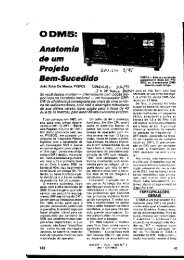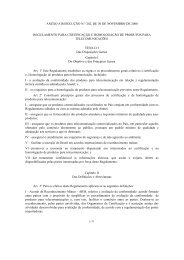A Software Defined Radio for the Masses, Part 3
A Software Defined Radio for the Masses, Part 3
A Software Defined Radio for the Masses, Part 3
Create successful ePaper yourself
Turn your PDF publications into a flip-book with our unique Google optimized e-Paper software.
<strong>for</strong> <strong>the</strong> PC SDR, contains a significant<br />
amount of code not illustrated here. I<br />
have chosen to focus this article on <strong>the</strong><br />
essential DSP code necessary <strong>for</strong><br />
modulation and demodulation in <strong>the</strong><br />
frequency domain. As time permits, I<br />
hope to write future articles that delve<br />
into o<strong>the</strong>r interesting aspects of <strong>the</strong><br />
software design.<br />
Fig 19 shows <strong>the</strong> completed frontpanel<br />
display of <strong>the</strong> SDR-1000. I have<br />
had a great deal of fun creating—and<br />
modifying many times—this user interface.<br />
Most features of <strong>the</strong> user interface<br />
are intuitive. Here are some<br />
interesting capabilities of <strong>the</strong> SDR-<br />
1000:<br />
• A real-time spectrum display with<br />
one-click frequency tuning using a<br />
mouse.<br />
• Dual, independent VFOs with database<br />
readout of band-plan allocation.<br />
The user can easily access and<br />
modify <strong>the</strong> band-plan database.<br />
• Mouse-wheel tuning with <strong>the</strong> ability<br />
to change <strong>the</strong> tuning rate with a<br />
click of <strong>the</strong> wheel.<br />
• A multifunction digital- and analogreadout<br />
meter <strong>for</strong> instantaneous<br />
and average signal strength, AGC<br />
gain, ADC input signal and DAC<br />
output signal levels.<br />
• Extensive VFO, band and mode control.<br />
The band-switch buttons also<br />
provide a multilevel memory on <strong>the</strong><br />
same band. This means that by<br />
pressing a given band button multiple<br />
times, it will cycle through <strong>the</strong><br />
last three frequencies visited on that<br />
band.<br />
• Virtually unlimited memory capability<br />
is provided through a Microsoft<br />
Access database interface. The<br />
memory includes all key settings of<br />
<strong>the</strong> radio by frequency. Frequencies<br />
may also be grouped <strong>for</strong> scanning.<br />
• Ten standard filter settings are<br />
provided on <strong>the</strong> front panel, plus independent,<br />
continuously variable<br />
filters <strong>for</strong> both CW and SSB.<br />
• Local and UTC real-time clock displays.<br />
• Given <strong>the</strong> capabilities of Visual<br />
Basic, <strong>the</strong> possibility <strong>for</strong> enhancement<br />
of <strong>the</strong> user interface is almost<br />
limitless. The hard part is “shooting<br />
<strong>the</strong> engineer” to get him to stop designing<br />
and get on <strong>the</strong> air.<br />
There is much more that can be<br />
accomplished in <strong>the</strong> DSP code to customize<br />
<strong>the</strong> PC SDR <strong>for</strong> a given application.<br />
For example, Leif Åsbrink,<br />
SM5BSZ, is doing interesting weaksignal<br />
moonbounce work under<br />
Linux. 16<br />
Also, Bob Larkin, W7PUA, is using<br />
10 Nov/Dec 2002<br />
Fig 19—SDR-1000 front-panel display.<br />
<strong>the</strong> DSP-10 he first described in <strong>the</strong><br />
September, October and November<br />
1999 issues of QST to experiment with<br />
weak-signal, over-<strong>the</strong>-horizon microwave<br />
propagation. 17<br />
Coming in <strong>the</strong> Final Article<br />
In <strong>the</strong> final article, I plan to describe<br />
ongoing development of <strong>the</strong><br />
SDR-1000 hardware. Included will be<br />
a tradeoff analysis of gain distribution,<br />
noise figure and dynamic range. I will<br />
also discuss various approaches to<br />
analog AGC and explore frequency<br />
control using <strong>the</strong> AD9854 quadrature<br />
DDS.<br />
Several readers have indicated interest<br />
in PC boards. To date, all prototype<br />
work has been done using<br />
“perfboards.” At least one reader has<br />
produced a circuit board, that person<br />
is willing to make boards available to<br />
o<strong>the</strong>r readers. If you e-mail me, I will<br />
gladly put you in contact with those<br />
who have built boards. I also plan to<br />
have a Web site up and running soon<br />
to provide ongoing updates on <strong>the</strong><br />
project.<br />
Notes<br />
1 G. Youngblood, AC5OG, “A <strong>Software</strong> <strong>Defined</strong><br />
<strong>Radio</strong> <strong>for</strong> <strong>the</strong> <strong>Masses</strong>, <strong>Part</strong> 1,” QEX,<br />
Jul/Aug 2002, pp 13-21.<br />
2 G. Youngblood, AC5OG, “A <strong>Software</strong> <strong>Defined</strong><br />
<strong>Radio</strong> <strong>for</strong> <strong>the</strong> <strong>Masses</strong>, <strong>Part</strong> 2,” QEX,<br />
Sep/Oct 2002, pp 10-18.<br />
3 The demonstration source code <strong>for</strong> this<br />
project may be downloaded from ARRLWeb<br />
at www.arrl.org/qexfiles/. Look <strong>for</strong><br />
1102Youngblood.zip.<br />
4 The functions of <strong>the</strong> Intel Signal Processing<br />
Library are now provided in <strong>the</strong> Intel Per<strong>for</strong>mance<br />
Primitives (Version 3.0, beta) package<br />
<strong>for</strong> Pentium processors and Itanium<br />
architectures. The IPP is available free to<br />
be downloaded from developer. intel.com/<br />
software/products/ipp/ipp30/index.htm.<br />
5 D. Hershberger, W9GR, and Dr S. Reyer,<br />
WA9VNJ, “Using The LMS Algorithm<br />
For QRM and QRN Reduction,” QEX,<br />
Sep 1992, pp 3-8.<br />
6 D. Hall, KF4KL, “Spectral Subtraction <strong>for</strong><br />
Eliminating Noise from Speech,” QEX,<br />
Apr 1996, pp 17-19.<br />
7 J. Bloom, KE3Z, “Correlation of Sampled<br />
Signals,” QEX, Feb 1996, pp 24-28.<br />
8 R. Lyons, Understanding Digital Signal<br />
Processing (Reading, Massachusetts:<br />
Addison-Wesley, 1997) pp 133, 330-340,<br />
429-430.<br />
9 D. Smith, KF6DX, Digital Signal Processing<br />
Technology (Newington, Connecticut:<br />
ARRL, 2001; ISBN: 0-87259-819-5; Order<br />
#8195) pp 4-1 through 4-15.<br />
10 D. Smith, KF6DX, “Signals, Samples and<br />
Stuff: A DSP Tutorial (<strong>Part</strong> 1),” QEX (Mar/<br />
Apr 1998), pp 5-6.<br />
11 In<strong>for</strong>mation on FFT convolution may be<br />
found in <strong>the</strong> following references:<br />
R. Lyons, Understanding Digital Signal Processing,<br />
(Addison-Wesley, 1997) pp 435-<br />
436; M. Frerking, Digital Signal Processing<br />
in Communication Systems (Boston, Massachusetts:<br />
Kluwer Academic Publishers)<br />
pp 202-209; and S. Smith, The Scientist<br />
and Engineer’s Guide to Digital Signal Processing<br />
(San Diego, Cali<strong>for</strong>nia: Cali<strong>for</strong>nia<br />
Technical Publishing) pp 311-318.<br />
12 S. Smith, The Scientist and Engineer’s<br />
Guide to Digital Signal Processing (Cali<strong>for</strong>nia<br />
Technical Publishing) pp 107-122. This<br />
is available <strong>for</strong> free download at www.<br />
DSPGuide.com.<br />
13 Overlap/add method: Ibid, Chapter 18, pp<br />
311-318; M. Freirking, pp 202-209.<br />
14 S. Smith, Chapter 9, pp 174-177.<br />
15 M. Frerking, Digital Signal Processing in<br />
Communication Systems, (Kluwer Academic<br />
Publishers) pp 237, 292-297, 328,<br />
339-342, 348.<br />
16 See Leif Åsbrink’s, SM5BSZ, Web site at<br />
ham.te.hik.se/homepage/sm5bsz/.<br />
17 See Bob Larkin’s, W7PUA, homepage at<br />
www.proaxis.com/~boblark/dsp10.htm.











